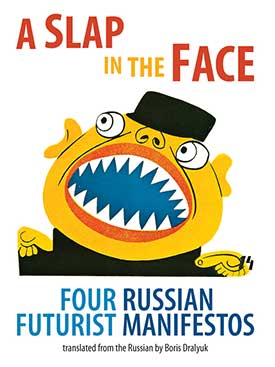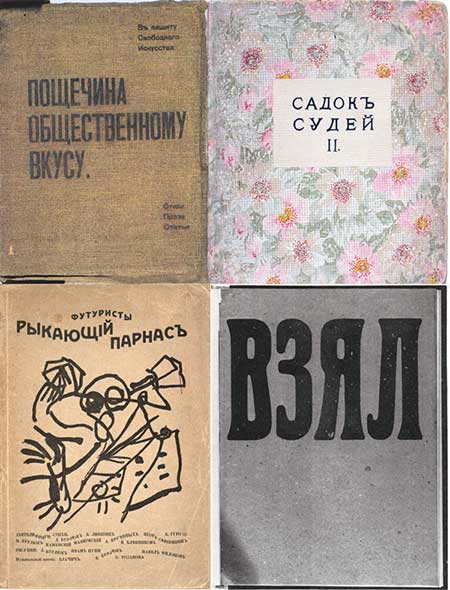 Hello Insert Blanc Readers! Recently, Saul Alpert-Abrams (an editorial assistant for the press) interviewed Boris Dralyuk, translator of A Slap in the Face: Four Russian Futurist Manifestos (now on pre-sale from Insert Blanc Press), over at the World Literature Today Blog.
Hello Insert Blanc Readers! Recently, Saul Alpert-Abrams (an editorial assistant for the press) interviewed Boris Dralyuk, translator of A Slap in the Face: Four Russian Futurist Manifestos (now on pre-sale from Insert Blanc Press), over at the World Literature Today Blog.
They talked about futurism, Russian politics, translation, and horses! Boris holds a PhD in Slavic languages and literature from UCLA and, among other things, is the translator of Leo Tolstoy’s How Much Land Does a Man Need (2010); co-translator of Polina Barskova’s The Zoo in Winter: Selected Poems (2011) and Dariusz Sośnicki’sThe World Shared: Poems (BOA Editions, forthcoming in 2014); and author of the monograph Western Crime Fiction Goes East: The Russian Pinkerton Craze 1907–1934 (2012). He is also co-editor, with Robert Chandler and Irina Mashinski, of the forthcoming Anthology of Russian Poetry from Pushkin to Brodsky (2015). He received first prize in the 2011 Compass Translation Award competition and, with Irina Mashinski, first prize in the 2012 Joseph Brodsky / Stephen Spender Translation Prize competition. I am sure you will enjoy his brilliant explanations and his bright new translations for Insert Blanc.
Saul Alpert-Abrams: What did you translate, and where and when were these originally published?

Boris Dralyuk: I translated four manifestos, each signed by one or more members of the most accomplished Russian futurist group, Hylaea; the first manifesto was published in Moscow, and the rest in St. Petersburg, or Petrograd, as that city was known during the Great War. Hylaea—which, as I write in my preface, never fully embraced the term “futurist”—fostered and fed off the talents of two great Russian poets, Velimir Khlebnikov and Vladimir Mayakovsky. Both Khlebnikov and Mayakovsky would prove too prodigiously talented and protean to be contained by any single group, much less by any collective manifesto’s declarations. And indeed, one of the interesting things to observe in this collection is the emergence of Mayakovsky’s voice; the first manifesto (1912) is signed by a core group of Hylaeans, the second (1913) by nearly the entire group, the third (1913–14) by the core members along with a newly inducted former antagonist (Igor Severyanin), and the last, “A Drop of Tar” from SEIZED (1915), is signed by Mayakovsky himself.
SAA: The manifestos claim a clean break from literary tradition, and although little is mentioned outright about politics, the polemic is distinctly subversive. To what extent are these manifestos a call to political reform as well? What, briefly, was the social situation under which these were composed?
BD: More than subversive—these people didn’t see themselves as sub- anything. They were superversive! They had to drag “Pushkin, Dostoevsky, Tolstoy, and so on, and so on” onto the “steamship of modernity” just so they could toss them off. The Hylaeans were at the helm from the start.
As for politics, well, that’s complicated. The Russian intelligentsia—to which the Hylaeans belonged, whether they liked it or not—were a fairly radicalized group. Not all were bomb-throwing terrorists, of course, but there really were Russian bomb-throwing terrorists; it wasn’t just a European cliché. Most of the older and well-established intelligentsia were what was called liberal—that is, reformist, seeking to secure civil liberties, a greater space for civil society. Only a relatively small set were out-and-out Marxists, and they too had split into numerous factions by the early 1900s. Nonetheless, there was a general sense that the time for reform was long overdue. Russia underwent the first of its three revolutions in 1905, after its disastrous defeat in the Russo-Japanese War; initially, the reformers gained some ground, but it all proved too much for the tsarist authorities, who initiated a reactionary crackdown in 1907. By 1911, when the Hylaeans emerged, Russian intellectuals sensed that the country—if not the whole world—was on the brink of . . . that they were dancing on the precipice of . . . well . . . something.
The Russian Hylaeans had no clear political program. They were more left than right, but that was a general trend. (It would have been very difficult for them to proclaim full allegiance to the tsarist regime. That would really have been a provocation, but of a very different sort!) Khlebnikov was a utopian thinker, embracing his own brand of pan-Slavism, and would become increasingly engrossed in mathematical calculations that he felt would predict the future. David Burlyuk was vaguely leftist, as was Benedikt Livshits—but the former emigrated after the revolution of 1917, and the latter was executed as an enemy of the people in 1938. Mayakovsky was the most politically radical member of Hylaea, and the closest to the Bolsheviks; he had been a member of the Bolshevik faction as early as 1908 and, after the October Revolution of 1917, proudly served the cause by pumping out slogans for posters, candy wrappers, etc. In 1922 he and his post-Revolutionary “futurist” colleagues founded LEF—the Left Front for Art; the former Hylaean, Kruchenykh, was also an associate, if not a full member. The 1920s were the heyday of futurist-Bolshevik collaboration. Mayakovsky’s suicide in 1930 marked the end of that period. It also secured his installation in the Soviet pantheon; once he was safely dead, Stalin proclaimed him “the best, most talented poet of our Soviet epoch.”
SAA: Where did the pre-Revolutionary futurists stand in the estimate of, say, Trotsky—one of the more sophisticated readers and literary critics among the Bolsheviks? Here’s a passage from his Literature and Revolution (1923–24):
Russian Futurism was born in a society which passed through the preparatory class of fighting the priest Rasputin, and was preparing for the democratic Revolution of February 1917. This gave our Futurism certain advantages. It caught rhythms of movement, of action, of attack, and of destruction which were as yet vague. It carried its struggle for a place in the sun more sharply, more resolutely and more noisily than all preceding schools, which was in accordance with its activist moods and points of view. To be sure, a young Futurist did not go to the factories and to the mills, but he made a lot of noise in cafes, he banged his fist upon music stands, he put on a yellow blouse, he painted his cheeks and threatened vaguely with his fist.
The workers’ Revolution in Russia broke loose before Futurism had time to free itself from its childish habits, from its yellow blouses, and from its excessive excitement, and before it could be officially recognized, that is, made into a politically harmless artistic school whose style is acceptable. The seizure of power by the proletariat caught Futurism still in the stage of being a persecuted group.
And this fact alone pushed Futurism towards the new masters of life, especially since the contact and rapprochement with the Revolution was made easier for Futurism by its philosophy, that is, by its lack of respect for old values and by its dynamics. But Futurism carried the features of its social origin, bourgeois Bohemia, into the new stage of its development.

BD: So what did the Hylaeans have in common with the Bolsheviks? An explosive hatred for the old order, and a common enemy—the bourgeois. There are two renderings of the French wordbourgeois in Russian:burzhua, a more-or-less neutral word, phonetically transcribed without malicious tweaking into Cyrillic script, and burzhuy, an ugly epithet. Here’s Mayakovsky’s most famous couplet, from 1917: “Eat your pineapples, chew your grouse, / Your last day draws near, you bourgeois louse!” The original rhymes “chew” (zhuy) with “bourgeois” (burzhuy). And there you have it: the bourgeois as a fat, contented consumer, chomping on game birds and sucking the marrow from their bones. And we, the artists of the future, should cater to his whims, grovel for his patronage? Not a chance. There’s some economic component to this critique, to be sure, but it’s primarily a matter of taste. The bourgeois is, first and foremost, a class enemy for the Bolsheviks and an aesthetic enemy for the Hylaeans.
SAA: What was the real threat to which the futurists were reacting in writers such as Pushkin, Tolstoy, and Dostoevsky?
BD: Not all the Hylaeans were ready to toss Pushkin, Tolstoy, and Dostoevsky overboard. Benedikt Livshits refused to sign the first manifesto because, as Vladimir Markov writes, “he knew the past too well . . . and he considered it hypocritical to debunk Pushkin while keeping his books under the pillows.” In general, Pushkin presented little to no threat in himself; it’s what had been made of Pushkin, the “white-marbled” statue, which inflamed the Hylaeans. But what do you expect? Pushkin is Russia’s “strongest” poet, in the Bloomian sense, and each generation enacts its agons in its own ways. The slash-and-burn agon of the Russian futurists may now seem as comically pathetic as it was exuberant, but it did produce new strong poets: in this case, Khlebnikov and Mayakovsky, and perhaps even Kruchenykh. Kruchenykh’s step away from the Russian literary tradition was surely the most radical. He founded a new poetics, called zaum, which is often translated as “transrational”; it literally means “beyond-mind,” so Paul Schmidt’s “beyonsense” may be the best rendering. Zaum, which was christened in Kruchenykh’s “Declaration of the Word as Such” (1913), liberated the word from bondage, establishing its supremacy over “common” sense: “the new word form creates new content, not the other way round.” In the collection Pomade (1913), he offered some examples of his new approach, “3 poems / written in / (my) own language / it differs from others: / its words have no / definite meaning,” the most famous of which is:
Dyr bul shchyl
ubesh shchur
skum
vy so bu
r l ehz
Some of these combinations of letters are impossible in Russian orthography (shch and y in“shchyl”); others are standard Russian words (vy is the formal/plural “you”; so is “with”) that lose their meaning in the new context. In a manifesto written later in 1913 and titled simply “Word as Such,” Kruchenykh and Khlebnikov claim that there’s “more of the Russian national [in ‘Dyr bul shchyl’] than there is in all of Pushkin’s poetry.” This new “beyonsense” poetry—an extreme form of askesis, if we’re to stay Bloomian about it—is a dead end, of course. For one, it requires headnotes and manifestos written in more or less comprehensible Russian, a language to which both Khlebnikov and Kruchenykh eventually returned. But the radical departure did its work, pushing Russian literature in a new direction at precisely the time when the old idols were in decline. Tolstoy had died in 1910, symbolism—the dominant poetic and literary movement of the preceding two decades—had entered into a “crisis” that same year, and the world to which both had responded was about to change utterly.
SAA: Today we are used to the manifesto as a genre, but in the early twentieth century it was a brand-new endeavor. What was so radical about the genre in and of itself, in this case? And who was its audience?
BD: Yes, the manifesto was a radical genre! A manifesto was not only a declaration of beliefs, but a declaration of war on all other movements. Who was the audience? The simplest answer is anyone who cared to read it—or to listen. As Mayakovsky writes in “A Drop of Tar,” these were speeches “to be delivered at the first favorable opportunity.” The futurists were masters at drawing crowds. Their yellow blouses, painted faces, suspended grand pianos “and so forth, and so forth,” represented the latest advances in épater la bourgeoisie but were also calculated to bring la bourgeoisie out in droves to their lectures and performances. Futurism became a fashion, and you can see the Hylaeans straining against this in the later manifestos. But they’d asked for it. Hell, Trotsky was right about futurism’s “social origin”: “bourgeois Bohemia.”
SAA: As David Shook says in the preface, “translation is literature’s salvation from provincialism, from the stagnancy that flourishes with insularity.” This brings to mind two questions. First, with a new and more experimental translation, what relevance will it have for readers now?
BD: Simply put, these manifestos are a lot of fun. And people interested in the movement—who want to know why it appealed to so many people, why it proved so provocative—deserve a translation that captures some of the originals’ spirit, energy, and charm. I like what David says about translation. I’ll add what Pushkin, the Hylaeans’ bête blanc, said on the matter. He called translators the “post-horses of enlightenment.” That’s not an insult; we get the message across. And horses are noble creatures. Even Mayakovsky urged us to have “A Good Attitude to Horses,” to treat them well, in his poem of 1918:
Horse, don’t cry.
Horse, please listen –
Why should you think you’re worse than they are?
Little one, look:
all of us are to some extent horses,
each of us is a horse in his own way.
(tr. Angela Livingstone)
And here’s another poem from an almost unknown futurist, a young man from my hometown, Odessa, who wrote under the pseudonym Anatoly Fioletov (1897–1918). It likely inspired Mayakovsky’s longer poem. Fioletov was gunned down by bandits who may have mistaken him for his brother, a famed detective and con artist named Osip Shor.
How admirably self-possessed –
these horses of a lower class,
who show complete indifference
to the troubles of existence.
How did we get on the subject of horses? I suppose it’s because I don’t really like talking about translation.
SAA: What is the significance of publishing this with Insert Blanc Press, a press focused on experimental literature?
BD: I think Insert Blanc is the perfect press for these manifestos. The proto-Hylaeans published their first collection, the original Trap for Judges, in 1910. They ordered the book to be printed on wallpaper. An extravagant choice, which drove the printers up the wall. On top of that, they couldn’t scrounge up the money to pay for it, so most of the copies stayed at the printers’ warehouse and eventually disappeared. There was no “art for art’s sake” at that print shop. At Insert Blanc, I’m blessed with a publisher who’d leap at the chance to work with wallpaper, and doesn’t expect me to shell out any cash. What more could I ask for?
Ultimately, the choice hinges on sympathy and solidarity. Insert Blanc has the right spirit—a commitment to the new, in whatever form it may take, as well as a respect for the history of innovation. There’s nothing quite as sad as thinking one is breaking new ground when that ground has long been broken. It behooves the avant-garde of today to know in whose hoofmarks they follow.
SAA: Finally, in A Drop of Tar, Mayakovsky addresses the problem of the death of futurism. To what extent do you believe that “today, all are futurists. The folk is a futurist”?
BD: This is a thoroughly ambiguous statement. In his own day, it may have meant that the people had caught up with futurism thanks to the conflagration of the Great War, which was rapidly destroying the old order. The war had already begun to take a toll on Russia; people were grumbling, and they’d soon do more than grumble. As for today, no, I don’t feel that the folk is a futurist. Maybe it could use a slap, if we could just get it all in one place at the same time.
Los Angeles, May 2013
